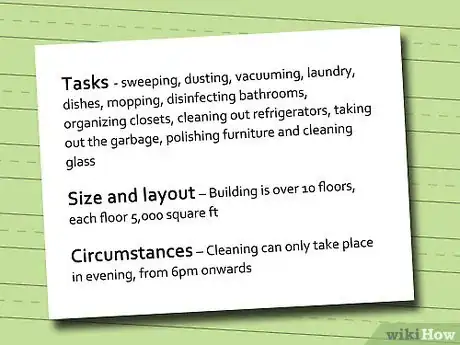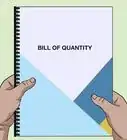This article was co-authored by Jon Gholian. Jon Gholian is a Cleaning Specialist and the Founder of Cleany, a home and office cleaning concierge service based in New York City, New Jersey & Miami. Cleany specializes in providing quality cleaning and handyman services to all their customers. All Cleany employees are insured, bonded, and professionally trained. Cleany has been featured in the New York Times, Bravo & Redfin.
This article has been viewed 86,937 times.
A cleaning job bid entails assessing the scope of a cleaning project and giving an estimation of the cost of completion. Cleaning bids may be for either residential or business jobs, and take into account both material and labor requirements. Follow these steps for how to write a cleaning bid.
Steps
-
1Determine your charging method. You may charge hourly, or per job. There are advantages and disadvantages to each method:
- Charging by the hour. This method is good for customers who want to pay for your services as they are needed, and it enables you to provide quick cleaning job bid quotes to customers who may not need your services regularly. For example, if a customer wants to hire you to assist for 4 hours in cleaning out a basement area before a remodeling, then you can easily provide a quote just based on the time frame. The drawbacks of charging by the hour are that some jobs may be more labor intensive than others, or may take more time than you had initially agreed on, requiring that you either approach the customer to ask for a larger fee before you complete the job, or complete the job for less than what you would normally charge. Additionally, when you write a cleaning bid that includes hourly rate for an indefinite number of hours (i.e. until the job is completed), you have no way of knowing exactly what you will end up making, which can make it hard to estimate your monthly income.
- Charging by the job. When writing a cleaning bid on a per-job basis, you are able to determine your income before you begin the job, and your customers can also work an exact cost into their budgets. This is convenient to creating a monthly income and expense plan, for both parties. However, know that when you bid a flat fee for a recurring cleaning job, there will be times when the job will take longer to complete, with no extra compensation for you, and/or when the job will take less time to complete, with no refund for the customer.[1]
-
2Calculate an hourly rate. Regardless of the charging method you choose (hourly or by the job), you will need to figure out a base hourly rate to build a cleaning bid on. Calculate your hourly rate the following way:
- Find out what your competition charges. Call cleaning services in the surrounding area and get a cleaning job bid from each of them. That way, you can establish a high and low range of hourly charges for cleaning in your area.[2]
- Research your area's cost of living. Consider the area's median income; if you live in a metropolis, you will be able to charge on the higher end, as opposed to a less-populated rural area, where you will not have the opportunity to charge as much.
- Incorporate the cost of cleaning materials and products into your hourly charge. If you choose not to use your own cleaning supplies, but rather the customer's, then at least include the average cost of things like cleaning gloves, clothes, paper towels and rags.
- Transportation. Factor in the cost of gas to travel to and from your cleaning jobs.
Advertisement -
3Assess the job you are writing a bid for. Bring a checklist with you to bid appointments and go over the job specifics with the customer, being sure to get a thorough understanding of exactly what the job entails.[3] Account for the following:
- Tasks. This encompasses the basic housekeeping duties required to complete the job, including things like sweeping, dusting, vacuuming, laundry, dishes, mopping, disinfecting bathrooms, organizing closets, cleaning out refrigerators, taking out the garbage, polishing furniture and cleaning glass.
- Size and layout. Take note of the space's square footage, as well as the amount of carpeting versus hard floors, the number of bathrooms and pool/deck/outdoor areas.
- Circumstances that add to a job's uniqueness and/or difficulty. If a job requires extraordinarily labor-intensive tasks or for you to work in a stressful or dangerous environment, you can raise your cleaning job bid to compensate. For example, if you are asked to clean tile grout, or to work in a house with a number of small dogs, then you can charge for the added effort accordingly.
-
4Use the information you gathered from your cleaning bid appointment to determine the number of hours it will take you to complete the job. Multiply that number by your hourly rate to get the amount you should charge for the cleaning job.
-
5Prepare a bid draft to give to the customer. Include in your bid details of the job that factored into the bid amount (tasks, size/layout and circumstances), the estimated time it will take to complete the job and the hourly charge (if charging per hour), the cleaning schedule and the total amount you will charge the customer for the cleaning job.
Community Q&A
-
QuestionHow do you calculated the price?
 Community Answeryou calculate it by the footage of the house, for example: 2500 sq. ft. X's $.30 ( of course the price per foot is totally up to you) , or you can look at the job and give them a flat price
Community Answeryou calculate it by the footage of the house, for example: 2500 sq. ft. X's $.30 ( of course the price per foot is totally up to you) , or you can look at the job and give them a flat price -
QuestionHow much do I charge for a pet in the condo while cleaning?
 Community AnswerYou could charge for any extra cost the pet may have caused you to incur.
Community AnswerYou could charge for any extra cost the pet may have caused you to incur. -
QuestionHow should I charge a big car lot when doing a cleaning bid?
 Community AnswerGet the square footage of the the car lot and charge between $5 - $7 per square foot.
Community AnswerGet the square footage of the the car lot and charge between $5 - $7 per square foot.


































































